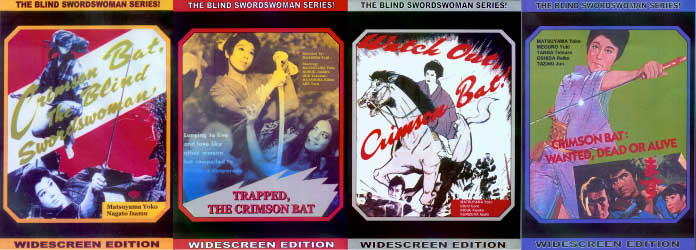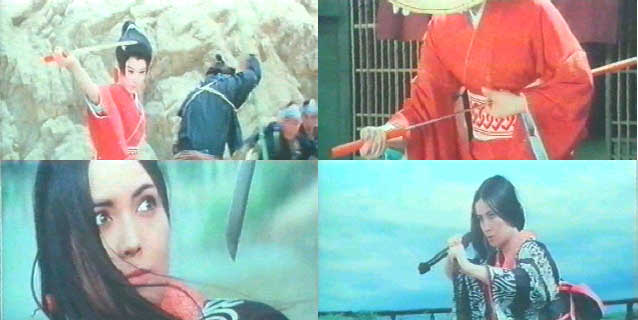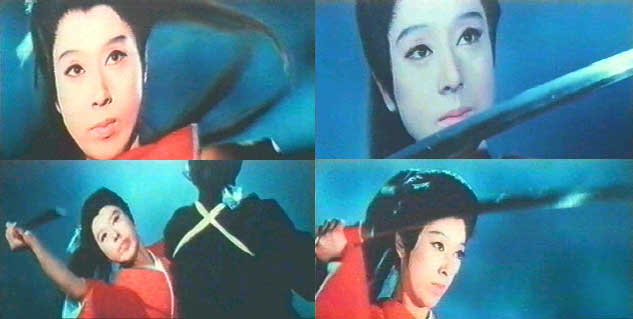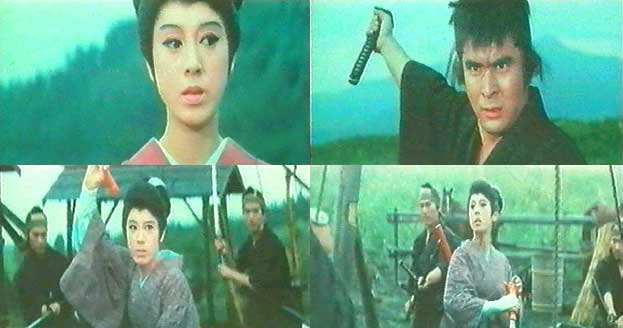The Crimson Bat

Though following a number of years after the
Zatoichi series was underway, this series beginning in 1969 from the Shochiku
film company was clearly influenced by it and possibly even trying to cash
in on its enduring popularity. Instead of a blind swordsman though, this
series centered on a blind swordswoman. The series only lasted for a little
over one year but in that time they made four episodes all running at around
85-minutes. The actress who played Oichi was Yoko Matsuyama – best known at
the time for her role on a television show rather than as a film actress.
She had been the main character on a popular show called “Seven Faces of Princess
Koto” in which she went undercover in feudal times to ferret out crime. After
the fourth episode of this series, Yoko quit the entertainment business to
focus on home life. The only other film credit I can find of hers is a 1966
film called “Judo Showdown” in which she apparently had a small role.

It is difficult not to compare these films to the Zatoichi series and in
most aspects they come up short. The films seem to be on a much smaller budget
in terms of production values and they are not able to re-create the sense
of Japan from those times as much of the running time takes place either
inside buildings or out in the open countryside. And not surprisingly, Yoko
is not able to emulate swordsmanship in the same way that Shintaro Katsu
was able to in the Zatoichi series – though to a large degree they use the
same technique. The films are also less ambitious with smaller set pieces
– though they get bigger in the last two films. Even so, the films are quite
enjoyable and Yoko creates a fascinatingly ambivalent character who manages
to keep surviving though this is not a life that she wants and one that she
sadly wishes she could leave. One can also only wonder if the Lady Snowblood
films would have been made without the success of these films.

Like Zatoichi she wanders about Japan on foot from town to town – though
unlike Zatoichi she is a bounty hunter rather than a masseuse and is always
impeccably dressed in kimonos with her hair pulled neatly back and her face
powdered in white. Her handicap and profession make her a loner, but in each
episode she finds herself tangled in other people’s problems and is forced
at some point to pull her sword out of its cane – sometimes reluctantly,
sometimes not. Though she tries to be tough and distant in love, she always
falls for someone and in return is desired by many men, but as she says in
one scene “I am not good for any man”. Deep down she wants only to be a normal
woman with husband and children but often feels unworthy of male love and
in the end she always walks away alone once again. She kills for her living,
but as often as not finds herself lending her sword to the side of the oppressed
for nothing – simply because it is the right thing to do.
The Crimson Bat: The Blind Swordswoman
Directed by: Matsuda Teiji
Year: 1969
Production Company: Shochiku
Running Time: 84 minutes
The first in the series gives a lot of background on Oichi through
various flashbacks. As a child her mother deserted her for a gambler and
in the same night the young girl had an accident that caused her to lose
her sight. Left alone in the world, a kindly older man takes her in and brings
her up, but her world is once again thrown into chaos when a group of men
show up one night and kill her adoptive father. She learns that her mother
is still alive and is now a brothel owner in another town and Oichi goes
to find her. On the way though she comes across the men who killed the old
man and she swings her cane wildly at them in anger and they decide that
she needs killing before she reveals too much to the wrong people. Fortunately,
a gruff samurai comes upon the scene and rescues her.

He sees something special in her – incredible instincts and reflexes - and
decides to train her to defend herself. She is a natural and within months
is a magnificent swordswoman – able to defend herself simply by sound and
her other senses. Before going their separate ways, he tells her to never
unsheathe her sword or she will never be able to live a normal life. With
these new found skills she moves on to look for her mother. In the narrative
that follows Oichi comes across her bitter mother, a man looking for his
daughter that he deserted twenty years previously and the man who killed
her adoptive father. Revenge ensues.

Trapped, Crimson Bat
Directed by: Matsuda Teiji
Year: 1969
Production Company: Shochiku
Running Time: 84 minutes
By the second film in the series, Oichi was using her specialized sword
skill as a bounty hunter – tracking men down and killing them in a flashing
display of quick swordplay. This is immediately announced as Oichi with her
large straw hat hiding her face waits outside an inn for a man with a price
of fifty gold pieces on his head . When he comes out she challenges him and
after a duel, she carts his lifeless body to the authorities for her reward.
She soon finds herself at odds with another female killer – the beautiful
Oen (Kikko Matsuoka – "Black Lizard") who carries around a bullwhip that
she uses with laughing glee. She and Oichi match up and Oichi makes the mistake
of showing her mercy which Oen returns with a pocketful of poisonous snakes
thrown at Oichi. One of them bites her and she stumbles off to die, but a
poor fisherman (Yasunori Irie) finds her and nurses her back to health.

The two of them slowly fall in love and Oichi relishes the idea of a normal
life, but as usual trouble finds her and the edge of her sword. Oen tracks
her down and brings along three experts in death to fight Oichi – but after
defeating them and coming across other problems in which her specialty is
needed, she realizes that she can never have a normal life – her sword which
she holds on to like a security blanket will always come between her and
such a life. So she walks away again – but not until one final terrific confrontation
with Oen and about thirty minions. This last fight is nicely staged and shot
– as they surround her Oen bends down in a formal crouch and waits for them
to attack. Later the fight becomes very theatrical as the background color
suddenly turns blue and it plays out in slo-motion and freeze frames to good
effect as if Oichi has entered another world where she is in perfect harmony
with her slashing blade. The plot and this final fight seemed perhaps to
be influential on the Hong Kong film "Deaf Mute Heroine" that came out in
1971.

Watch Out Crimson Bat
Directed by: Ichimura Hirokazu
Year: 1969
Production Company: Shochiku
Running Time: 84 minutes
Within a few minutes of the film's beginning Oichi finds herself in
the middle of trouble and knee deep in dead men. A horseman is shot and he
falls off but is dragged behind as the horse races down a country road. Oichi
hears this and times it just perfectly as she cuts him loose from the horse.
It is too late though and on the verge of death, he asks Oichi to deliver
a scroll to a man in a nearby village. She accepts his final wish. Soon men
looking for the scroll surround her but wish they hadn’t. As she proceeds
with her mission, she runs into two orphans and takes them under her wing
and then comes across a samurai (Goro Ibuki) who having witnessed her ability
needs to challenge her to a duel. The duel is interrupted though before blood
is drawn, but he is able to take the scroll away from her.

With her pride damaged, she decides to continue on her quest and goes to
the town to look for the samurai with a horde of men still after her since
they don’t know she has lost the scroll. The town is under a black cloud
– a wealthy man is trying to concoct an explosive device and using the townspeople
to make it – with many deaths being the result. The scroll has the correct
formula to do this and they attack Oichi to get it. She is forced off a cliff
and the samurai finds her and nurses her back to health – and yes they begin
to fall in love! Few men can resist a woman with a sharp sword. Other complications
ensue to the point where she once again finds it necessary to walk away from
people who care about her. When she learns though that the munitions magnate
is holding her friends captive, she jumps on a horse and rides into a camp
full of waiting killers. This is a fairly large scale bloody fight as this
third film in the series definitely notches up the body count.

Crimson Bat: Wanted Dead or Alive
Directed by: Ichimura Hirokazu
Year: 1970
Production Company: Shochiku
Running Time: 83 minutes
The final appearance of the Crimson Bat (a name by the way that appears
totally fabricated by the West – there is no reference to it in the films)
is the best of the lot – full of action, drama and romance. Oichi helps a
woman escape the clutches of a high government official to go off with the
man she loves. The official puts a reward on her head of fifty gold pieces
and soon a menagerie of bounty hunters is after her skin. Three of
them band together to accomplish this – one an expert swordsman, another
a huge judo master and the third is deadly with a chain. To escape, she heads
for the fishing town of Itso but soon comes face to face with Sankuro (Yuki
Maguro – Omi in "Shogun"), the swordsman. Their duel in the desert is interrupted
by a sandstorm in which Oichi is able to vanish.

Once in Itso Oichi wants only to mind her own business, but the troubles
within the town are soon bumping up against her conscious. A corrupt local
official – reporting to the one that is after Oichi – has been tasked by
Edo to move out the fishermen and build a port in the town. The fishermen
want compensation for this, but he refuses to hand it out and he and his
men begin to bully the fishermen to to move them out. When a group of hooligans
begin pushing around a woman next door to Oichi she ignores it – but when
the woman's child is beaten Oichi is soon in the middle of it and knocking
the men about (using only her cane which she does when she wants to only
teach a lesson in civility). The three bounty hunters also show up, but Sankuro
begins to find Oichi most appealing and assists her to escape the other two.
Oichi sides with the fishermen in their struggle and comes against a master
samurai (Tanba Tetsuro) and a large band of bad guys. The finale turns bloody
as she strides into town and does a mini-Azumi on them.
 Like the Zatoichi films, the character of Oichi grows on the viewer with
each episode as she tries to find a place for herself in society – though
in the end her talent with the sword curses her attempts to do so. In some
ways she is a more complicated figure than Zatoichi who seems to accept his
fate in life and so enjoys the little pleasures – she rails against her fate
but also takes great pride and at times pleasure in her ability to wield
a sword. It is a shame that the series ended so quickly with so many more
miles to go for Oichi.
Like the Zatoichi films, the character of Oichi grows on the viewer with
each episode as she tries to find a place for herself in society – though
in the end her talent with the sword curses her attempts to do so. In some
ways she is a more complicated figure than Zatoichi who seems to accept his
fate in life and so enjoys the little pleasures – she rails against her fate
but also takes great pride and at times pleasure in her ability to wield
a sword. It is a shame that the series ended so quickly with so many more
miles to go for Oichi.

As far as I know, the films are only out on poor DVD transfers from VHS sources
that are dubbed into English and have Danish subtitles. No doubt a good transfer
and in Japanese, the films would be even better. As it is:
My rating for the series: 7.5
Background information on series and actress from "Japanese Cinema:
The Essential Handbook"














